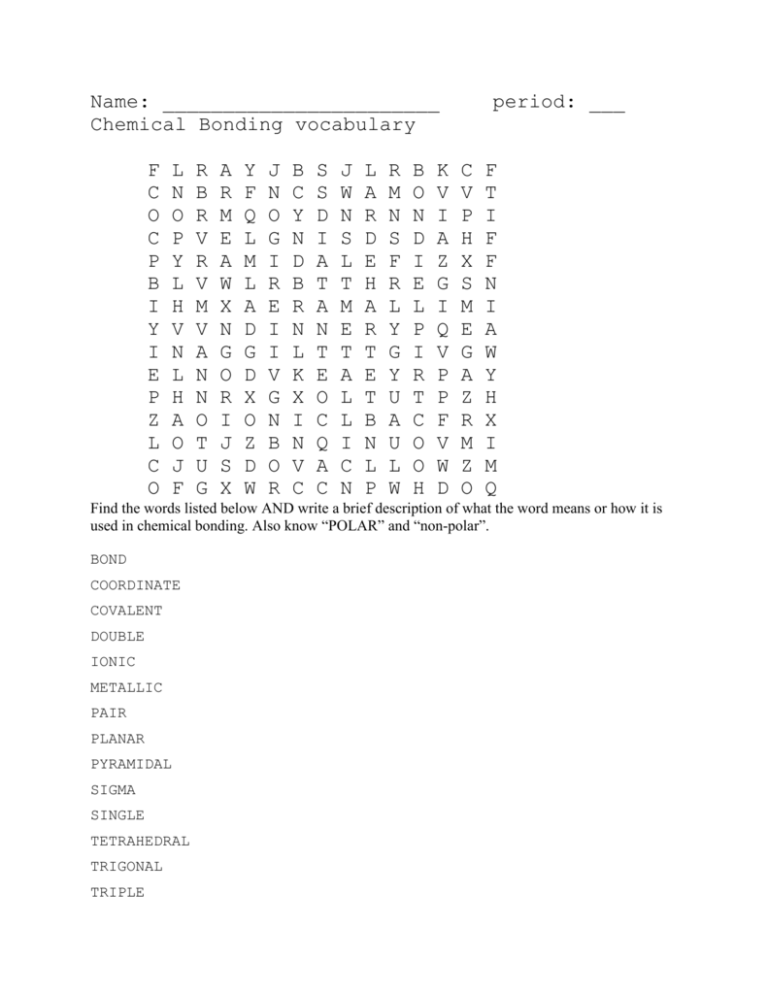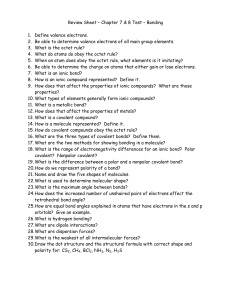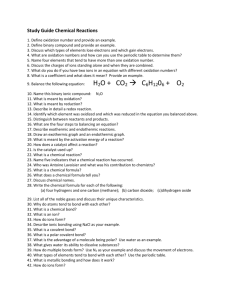Bonding vocabulary
advertisement

Name: _______________________ Chemical Bonding vocabulary F C O C P B I Y I E P Z L C O L N O P Y L H V N L H A O J F R B R V R V M V A N N O T U G A R M E A W X N G O R I J S X Y F Q L M L A D G D X O Z D W J N O G I R E I I V G N B O R B C Y N D B R N L K X I N V C S S D I A T A N T E O C Q A C J W N S L T M E T A L L I C N L A R D E H A R T E T B N L P R M N S F R L Y G Y U A U L W B O N D I E L P I R T C O O H K V I A Z G I Q V P P F V W D period: ___ C V P H X S M E G A Z R M Z O F T I F F N I A W Y H X I M Q Find the words listed below AND write a brief description of what the word means or how it is used in chemical bonding. Also know “POLAR” and “non-polar”. BOND COORDINATE COVALENT DOUBLE IONIC METALLIC PAIR PLANAR PYRAMIDAL SIGMA SINGLE TETRAHEDRAL TRIGONAL TRIPLE Find the words listed below AND write a brief description of what the word means or how it is used in chemical bonding. BOND: when electrons are transferred or shared between elements to for a new substance COORDINATE: a type of bond where the Lewis dot structure is drawn as if both electrons used in bonding were donated by the same element(atom) COVALENT: a type of bond (between two non-metals) where the electrons are shared DOUBLE: a covalent bond where 2 pairs (4 electrons) are shared; this is a type of “pi” bond that is rigid and doesn’t “spin” IONIC: a type of bond where electrons are transferred to form cations and anions METALLIC: the type of bonding that occurs in metals described as a bunch of cations surrounded by a “sea of electrons”; helps explain why metals are malleable. PAIR: two electrons that form a bond or just take up space and push the other electrons away (VSEPR theory or shapes) PLANAR: a flat molecular shape that results from 3 bonds and no lone electron pairs (the shape Boron likes to make) PYRAMIDAL: a polar molecular shape like Nitrogen likes to make SIGMA: another name for a single covalent bond that helps us remember that it allows the molecular shape to “spin” SINGLE: when two electrons are involved in a covalent bond TETRAHEDRAL: the 3-dimensional shape formed when an atoms bonds 4 times (like carbon) TRIGONAL: when there are three bonds coming from a central atom (usually part of trigonal planner) TRIPLE: a type of covalent bond where 6 electrons (three pair) are involved in bonding, this is another type of “pi” (or rigid) bond Solution + C + + P + + + + + P + L C + + + O + Y + + + + L + A O + + + + + V R + + + A + N O + + + + + + E A + + N + O R I + + + + + + L M L A + G D + O + + + + + + G I R E I I + + N + + + + + + N D + R N + + + I + + + + + + I A T A + T E + C + + + + + + S L T M E T A L L I C + L A R D E H A R T E T B + + + + + + S + R + + + + + + U + + B O N D I E L P I R T + + O + (Over,Down,Direction) BOND(12,1,S) COORDINATE(1,14,NE) COVALENT(1,2,SE) DOUBLE(13,15,NW) IONIC(4,12,E) METALLIC(9,7,S) PAIR(14,3,SW) PLANAR(1,11,NE) PYRAMIDAL(1,5,E) SIGMA(11,4,SE) SINGLE(9,4,W) TETRAHEDRAL(10,11,N) TRIGONAL(8,6,SW) + + + A + G + + + + + + + + D + + P + + + M + + + + + + + + + + + + + + + A + + + + + + + Better Vocabulary to know for Chapter 8 (Online text) /Chapter 15 (desk copy) Lewis (Electron) Dot Structures Ionic Bond Covalent Bond Electrolyte Polar Nonpolar Electronegativity Octet Rule VSEPR theory Hybridization theory Tetrahedral Trigonal Planar Trigonal Pyramidal Double bond Triple Bond What kinds of things are electrolytes? Does pure water conduct electricity? Why does water with you in it conduct electricity







